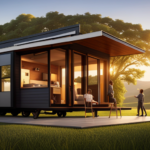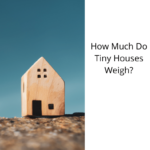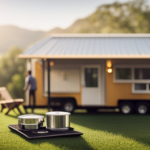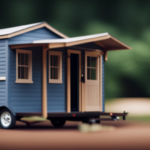Beginners Guides
How Heavy Is A Tiny House On Wheels
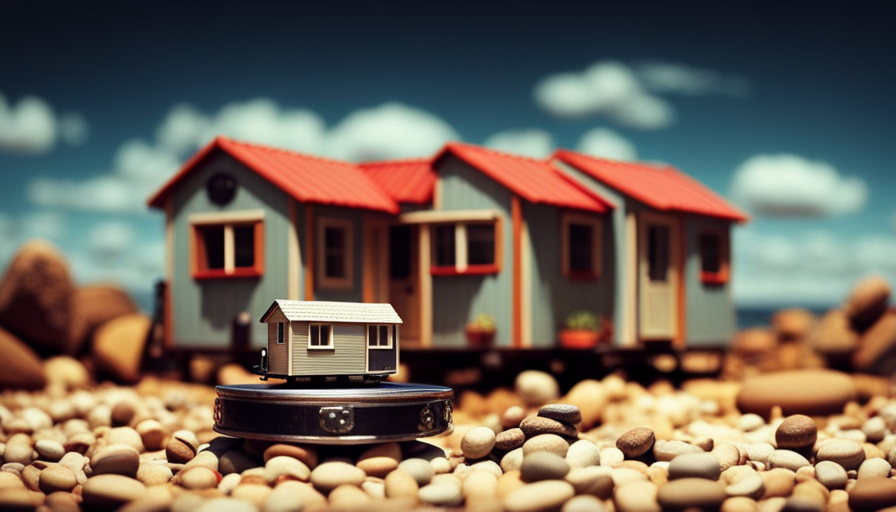
Regarding tiny houses on wheels, their mass is akin to an unseen peak. They may appear featherlight at first glance, yet in truth, they bear a significant weight.
As a passionate advocate for the tiny house movement, I have dived deep into the world of mobile dwellings and discovered the intricate details of their weight. In this article, we will explore the factors that contribute to the heaviness of a tiny house on wheels and the challenges it presents.
From the construction materials used to the weight of appliances and personal belongings, every ounce counts. We will also discuss the structural considerations, trailer capacity, and design that play a crucial role in weight distribution.
Furthermore, we will provide tips on how to reduce weight and maximize space without compromising structural integrity. So, buckle up and get ready for a technical journey into the weighty world of mobile tiny houses.
Key Takeaways
- Weight considerations are important in the construction of tiny houses on wheels.
- Lightweight construction materials, such as aluminum and composite panels, are commonly used to reduce weight.
- Advanced framing techniques can be employed to reduce weight without compromising the structure of the house.
- Proper weight distribution is crucial for stability and safety while towing, and heavier items should be placed near the center of the house for even distribution.
Understanding the Construction Materials Used
So, you’re probably wondering what exactly goes into building a tiny house on wheels, huh? Well, let me break it down for you. When it comes to construction techniques, there are a few key factors to consider in order to keep the weight of the tiny house on wheels as low as possible.
One important aspect is the material selection. Lightweight materials such as aluminum and composite panels are commonly used to reduce the overall weight. These materials aren’t just strong and durable, but they also help to increase fuel efficiency when towing the house. Additionally, innovative construction methods, like using advanced framing techniques, can further reduce the weight without compromising structural integrity.
Now, let’s talk about the impact of appliances and furnishings on weight. While the construction materials play a significant role, the weight of appliances and furnishings shouldn’t be overlooked. Every pound adds up, so it’s important to carefully consider the weight of each item being added to the tiny house. Opting for lightweight appliances and furnishings, such as compact and energy-efficient models, can make a big difference. Additionally, minimizing the number of items and choosing multi-functional pieces can help to keep the overall weight down.
So, now that we’ve covered the construction materials and their impact on weight, let’s move on to the next section about the design considerations for weight distribution.
The Impact of Appliances and Furnishings on Weight
Imagine the weight of your dreams and desires, encapsulated within the carefully chosen appliances and furnishings of your humble abode on wheels. When it comes to tiny houses on wheels, every choice you make for appliances and furniture can have a significant impact on the overall weight of your home. Let’s take a closer look at how these factors play a role.
To help you understand the weight implications, take a look at the table below. It showcases common appliances and their average weights, along with popular furniture choices and their corresponding weights. This information can help you make informed decisions when it comes to selecting appliances and furnishings for your tiny house on wheels.
| Appliance | Average Weight (lbs) |
|---|---|
| Refrigerator | 100-300 |
| Stove/Oven | 30-100 |
| Washer/Dryer Combo | 150-200 |
| Air Conditioner | 50-150 |
| Furniture | Average Weight (lbs) |
|---|---|
| Bed Frame | 50-100 |
| Sofa | 100-200 |
| Dining Table | 50-100 |
| Chairs | 10-50 |
By carefully considering the weight of your appliances and furniture, you can ensure that your tiny house on wheels remains within safe weight limits. However, it’s not just appliances and furnishings you need to consider. The weight of your personal belongings also plays a significant role in the overall weight of your tiny house on wheels.
Considering the Weight of Personal Belongings
As I pack my cherished belongings, the weight of my memories and treasures becomes a tangible reminder of the life I’m leaving behind. When considering the weight of personal belongings in a tiny house on wheels, it’s important to pay attention to weight distribution and minimize clutter.
Weight distribution plays a crucial role in maintaining stability and safety while towing or moving a tiny house on wheels. By strategically placing heavier items near the center of the house, the overall weight can be evenly distributed, reducing the risk of imbalance and potential accidents. It’s also essential to avoid overloading one side of the house, as this can lead to issues with weight distribution and affect the overall towing experience.
Additionally, minimizing clutter is key to keeping the weight of personal belongings in check. As tempting as it may be to bring along every sentimental item, it’s important to prioritize and only pack what’s truly necessary. This not only helps to reduce the overall weight of the tiny house but also ensures that there’s enough space for essential items and allows for efficient weight distribution.
Considering weight distribution and minimizing clutter are essential aspects when packing personal belongings for a tiny house on wheels. By carefully considering these factors, the overall weight can be managed effectively, ensuring a safe and stable towing experience. Moving on to the next section, let’s delve into the structural considerations for weight distribution.
Structural Considerations for Weight Distribution
When it comes to ensuring a smooth and enjoyable towing experience in a mobile home, it’s crucial to carefully consider the structural aspects that contribute to effective weight distribution.
The construction materials used in building a tiny house on wheels play a significant role in determining its weight and overall towing performance. Opting for lightweight materials such as light-gauge steel or engineered wood can help reduce the overall weight of the structure without compromising on strength and durability. Additionally, using efficient insulation materials like spray foam can help maintain a comfortable interior temperature while minimizing weight gain.
Another critical consideration for weight distribution is the trailer capacity. The trailer on which the tiny house is built must have sufficient load-bearing capacity to support the weight of the structure and all its contents. It is essential to calculate the total weight of the tiny house, including personal belongings and appliances, to ensure it falls within the trailer’s weight limits. Exceeding the trailer’s capacity can lead to safety hazards and affect towing performance.
When designing a tiny house on wheels, careful attention to construction materials and trailer capacity is necessary to achieve optimal weight distribution and towing experience. The importance of trailer capacity and design will be further explored in the subsequent section.
The Importance of Trailer Capacity and Design
The significance of the trailer’s capacity and design cannot be overstated as it directly impacts the overall towing performance and safety of a mobile home.
When considering the weight of a tiny house on wheels, it’s crucial to understand the trailer weight capacity and design considerations. The weight capacity of the trailer refers to the maximum weight it can safely carry. Exceeding this capacity can lead to structural damage, increased wear and tear on the trailer, and compromised safety while towing.
Trailer design considerations are also essential in determining the weight distribution and stability of the tiny house on wheels. Factors such as axle placement, trailer length, and frame construction play a vital role in ensuring a balanced load and optimal towing performance. Improper design can result in a trailer that’s difficult to control, prone to swaying, and potentially hazardous on the road.
Understanding the trailer’s weight capacity and design considerations is crucial for a safe and efficient towing experience with a tiny house on wheels. By adhering to these specifications, you can ensure that your mobile home is well-supported and properly balanced during travel.
With this in mind, let’s now explore the regulations and restrictions for road travel with a tiny house on wheels.
Regulations and Restrictions for Road Travel
In the previous section, we discussed the importance of trailer capacity and design when it comes to the weight of a tiny house on wheels. Now, let’s delve into the regulations and restrictions for road travel that need to be considered to ensure compliance and safety.
When it comes to transporting a tiny house on wheels, there are certain weight restrictions that must be adhered to. These regulations vary from state to state, so it’s crucial to familiarize yourself with the specific rules in your area. Exceeding these weight limits can result in fines, penalties, or even the inability to travel on certain roads.
To help you understand the importance of complying with these regulations, here are a few key points to consider:
-
Safety: Adhering to weight restrictions ensures the structural integrity of the tiny house and its trailer, reducing the risk of accidents or damage during transport.
-
Legal Compliance: Avoiding fines and penalties by following the regulations ensures a smooth and hassle-free journey.
-
Road Damage: Overloading a tiny house on wheels can cause damage to roads and infrastructure, so it’s essential to distribute the weight properly.
-
Insurance Coverage: Non-compliance with weight restrictions may void your insurance coverage, leaving you vulnerable in case of any mishaps.
Now that we have covered the regulations and restrictions for road travel, let’s move on to the next section, where we will discuss the importance of balancing weight with mobility and maneuverability.
Balancing Weight with Mobility and Maneuverability
Achieving a proper balance between weight and mobility is crucial for ensuring the smooth and effortless maneuverability of your mobile home, like a well-tuned ballet dancer gracefully gliding across the stage.
Balancing weight is a complex task that requires careful design considerations. The overall weight of a tiny house on wheels must be carefully distributed to avoid putting excessive strain on the trailer and compromising its structural integrity. This involves strategically placing heavy components, such as appliances and furniture, over the axles to evenly distribute the weight.
Additionally, optimizing the design to minimize unnecessary weight is essential. This can be achieved by using lightweight materials for construction, such as aluminum or composite panels, and avoiding excessive interior finishes or decorations. It’s also important to consider the weight of the trailer itself, as it’ll contribute to the overall weight of the tiny house.
By carefully balancing weight and incorporating design considerations, you can ensure that your tiny house on wheels maintains optimal mobility and maneuverability.
Transitioning into the subsequent section about calculating the total weight, it’s essential to have an accurate understanding of the weight distribution to ensure safe road travel.
Calculating the Total Weight of a Tiny House on Wheels
To accurately determine the total weight of your mobile home, you’ll need to calculate the combined weight of all components and furnishings, ensuring a safe and comfortable journey on the road. Here’s a breakdown of the key factors involved in calculating the weight of a tiny house on wheels:
-
Calculating weight distribution: It’s crucial to distribute the weight evenly throughout the tiny house to maintain stability during transportation. By considering the placement of heavy items such as appliances, furniture, and water tanks, you can achieve optimal weight distribution.
-
Trailer capacity and design: The weight-bearing capacity of your trailer is an essential factor in determining the total weight of your tiny house. Be sure to consult the manufacturer’s specifications and ensure that your trailer is designed to handle the weight of your home.
-
Considering additional weight: Don’t forget to account for the weight of essential systems like plumbing, electrical wiring, and insulation. These components can add significant weight to your tiny house.
By carefully calculating the weight distribution, considering the trailer capacity and design, and accounting for additional weight, you can accurately determine the total weight of your tiny house on wheels. This information will help you make informed decisions about reducing weight and maximizing space in the subsequent section about tips for reducing weight and maximizing space.
Tips for Reducing Weight and Maximizing Space
When looking to lighten your load and create more room, consider these tips for cutting weight and optimizing space in your mobile home.
Maximizing storage is crucial in a tiny house on wheels, and there are several strategies you can employ. First, utilize vertical space by installing shelves and cabinets that reach all the way up to the ceiling. This allows you to store items without taking up valuable floor space.
Additionally, consider using lightweight materials for your furniture and fixtures. Opt for materials like aluminum or bamboo, which are durable yet significantly lighter than traditional options. Another way to reduce weight is by choosing multipurpose furniture, such as a sofa that can be converted into a bed or a dining table that can be folded away when not in use.
Lastly, think about utilizing hidden storage options, such as under-bed compartments or built-in storage solutions. By implementing these tips, you can maximize storage and create a more spacious living environment in your tiny house on wheels.
Transitioning into the next section, living in a mobile tiny house presents both benefits and challenges.
The Benefits and Challenges of Living in a Mobile Tiny House
Living life on the move in a miniature abode like this can be both liberating and demanding, akin to navigating a nomadic journey through uncharted territories. The benefits of downsizing to a mobile tiny house are numerous. Firstly, it allows for a simpler and more minimalist lifestyle, with less clutter and fewer possessions. This can lead to a greater sense of freedom and a reduced environmental impact. Secondly, living off the grid in a mobile tiny house provides the opportunity to disconnect from the traditional utilities and live a more self-sufficient life. This can be empowering and rewarding, knowing that you are relying on your own resources and minimizing your dependence on external systems. However, this lifestyle also presents its fair share of challenges. One of the main challenges is the limited space available in a tiny house, which requires careful organization and efficient use of every square inch. Additionally, living off the grid can require a significant amount of planning and preparation, as you need to ensure a reliable power source and access to water and waste management systems. Overall, while living in a mobile tiny house offers many benefits, it also requires careful consideration and adaptation to overcome the challenges of off-grid living.
| Benefits of Downsizing | Challenges of Off-Grid Living | |
|---|---|---|
| Simpler, minimalist lifestyle | Limited space | |
| Reduced environmental impact | Planning and preparation | |
| Self-sufficiency | Reliable power source | |
| Freedom and independence | Water and waste management | |
| Minimal dependence on external systems |
Frequently Asked Questions
Can I build a tiny house on wheels with any type of construction materials?
I can build a tiny house on wheels with a variety of construction materials, but I must consider building codes and cost considerations.
Building codes dictate the standards for safety and structural integrity, so I need to ensure that the chosen materials meet these requirements.
Additionally, cost considerations are crucial as some materials may be more expensive than others.
By carefully selecting construction materials, I can create a tiny house on wheels that meets both building codes and cost constraints.
How do appliances and furnishings affect the weight of a tiny house on wheels?
Appliance weight and furnishing weight greatly impact the overall weight of a tiny house on wheels. Appliances such as refrigerators, stoves, and washing machines can add significant weight, while furnishings like beds, couches, and cabinets also contribute.
Considering the weight of each individual appliance and furnishing is crucial when designing a tiny house on wheels to ensure it remains within safe weight limits. Failure to properly account for these weights can lead to stability issues and potential damage during transportation.
Is it necessary to consider the weight of personal belongings when designing a tiny house on wheels?
When designing a tiny house on wheels, it’s crucial to consider the weight of personal belongings. Not only does this impact the overall weight of the house, but it also affects weight distribution planning.
Personal belongings can add significant weight, and if not properly accounted for, they can lead to imbalance and potential safety issues. Therefore, it’s essential to carefully assess and allocate weight limits for personal items to ensure proper stability and functionality of the tiny house on wheels.
What are the structural considerations for weight distribution in a tiny house on wheels?
When it comes to designing a tiny house on wheels, structural considerations and weight distribution are of utmost importance. The placement and distribution of weight throughout the structure must be carefully planned to ensure stability and safety while on the move.
Factors such as the location of heavy appliances, the positioning of water tanks, and the use of sturdy materials all contribute to maintaining a well-balanced and secure tiny house on wheels.
Are there any regulations or restrictions for road travel with a tiny house on wheels?
There are regulations and restrictions that apply to road travel with a tiny house on wheels. These rules vary depending on the jurisdiction and can include limits on the overall dimensions, weight, and height of the structure. It’s important to comply with these regulations to ensure safe and legal transportation. Additionally, permits or special licenses may be required for towing a tiny house on public roads. Always consult local authorities and transportation agencies for specific requirements in your area.
Conclusion
In conclusion, understanding the weight of a tiny house on wheels is essential for a successful and safe mobile living experience. Every element contributes to the overall weight, from the construction materials to the appliances and even personal belongings. Balancing weight and mobility is crucial for a smooth and enjoyable journey. So, imagine your tiny house on wheels as a graceful ballerina, effortlessly gliding across the road. It is supported by a well-designed trailer and optimized weight distribution. With careful planning and consideration, you can create a mobile tiny house that’s both lightweight and spacious. It offers you the freedom to wander and explore.
Hi, I’m Emma. I’m the Editor in Chief of Tiny House 43, a blog all about tiny houses. While tree houses are often associated with childhood, they can be the perfect adult retreat. They offer a cozy space to relax and unwind, surrounded by nature. And since they’re typically built on stilts or raised platforms, they offer stunning views that traditional homes simply can’t match. If you’re looking for a unique and romantic getaway, a tree house tiny house might just be the perfect option.
Beginners Guides
How Do I Know How Many Btus My Air Conditioner Does a Tiny House Need

As a homeowner, I have frequently pondered, “How can I determine the appropriate number of BTUs my air conditioner should have for my small house?” This is a common yet essential question. Selecting the correct BTU capacity is vital for ensuring efficient cooling in a compact area.
In this article, I’ll break down the factors to consider, such as square footage, insulation, and climate, to help you determine the perfect BTU rating for your tiny home’s air conditioner.
So, let’s dive in and find the answer together.
Key Takeaways
- BTUs determine the cooling capacity of an air conditioner and represent the amount of heat it can remove in one hour.
- Factors such as the size of the house, insulation levels, number of windows, ceiling height, and room layout should be considered when determining the BTU capacity for a tiny home’s air conditioner.
- Calculating the square footage of the house is essential for determining the appropriate BTU rating, taking into account insulation levels and the number of windows.
- Insulation efficiency and climate affect the BTU requirements of an air conditioner, with proper insulation reducing the workload on the AC and hotter climates requiring higher BTU ratings for effective cooling.
Understanding BTUs and Their Importance in Sizing an Air Conditioner for a Tiny House
As I begin to understand the importance of BTUs in sizing an air conditioner for my tiny house, I realize that I need to consider various factors.
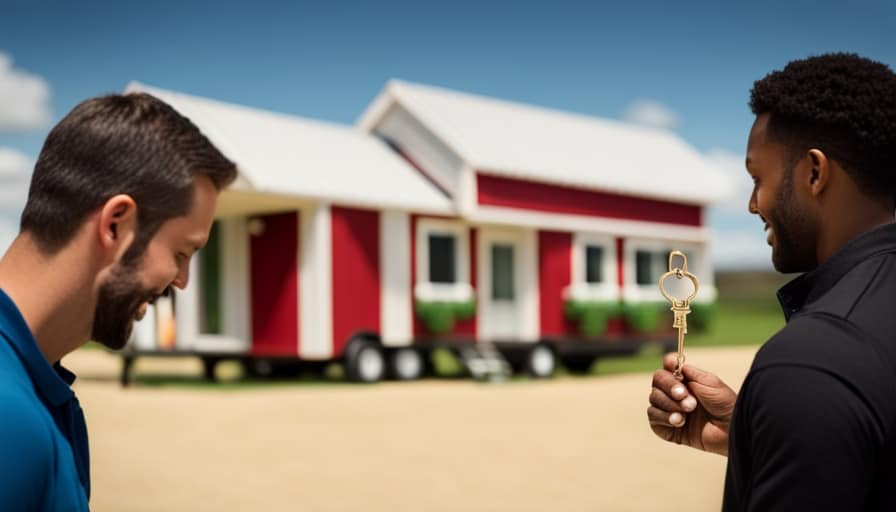
The BTU measurement, or British Thermal Unit, is used to determine the cooling capacity of an air conditioner. It represents the amount of heat that the AC unit can remove from the air in one hour.
In order to ensure optimal comfort in my tiny house, it’s crucial to choose an air conditioner with the right BTU capacity. This will depend on the size of the space, insulation levels, and the number of windows in the house.
Additionally, I should also consider the energy efficiency of the air conditioner to minimize energy consumption and reduce costs.
Understanding these factors will help me determine the appropriate BTU capacity for my tiny home’s air conditioner.

Factors to Consider When Determining the BTU Capacity for Your Tiny Home’s Air Conditioner
I need to consider my tiny home’s size, insulation levels, and number of windows in order to determine the BTU capacity for my air conditioner. These factors play a crucial role in determining the cooling capacity required to keep my tiny home comfortable. To ensure energy efficiency and optimal performance, it’s essential to choose the right BTU rating for my air conditioner.
Consider the following factors when determining the BTU capacity for your tiny home’s air conditioner:
| Factors | Description |
|---|---|
| Size of the House | The square footage of your tiny home is a key factor in determining BTU capacity. A larger space will require a higher cooling capacity. |
| Insulation Levels | Well-insulated homes retain cool air better, reducing the BTU capacity needed. |
| Number of Windows | Windows contribute to heat gain. More windows may require a higher BTU capacity. |
Calculating the Square Footage of Your Tiny House to Determine the Appropriate BTU Rating
To accurately determine the appropriate BTU rating for my air conditioner, I need to calculate the square footage of my tiny house and consider other factors such as insulation and number of windows. Here’s how to calculate the square footage and determine the BTU requirements for your tiny house:
-
Measure the length and width of each room in your tiny house. Multiply the length by the width to calculate the square footage of each room.
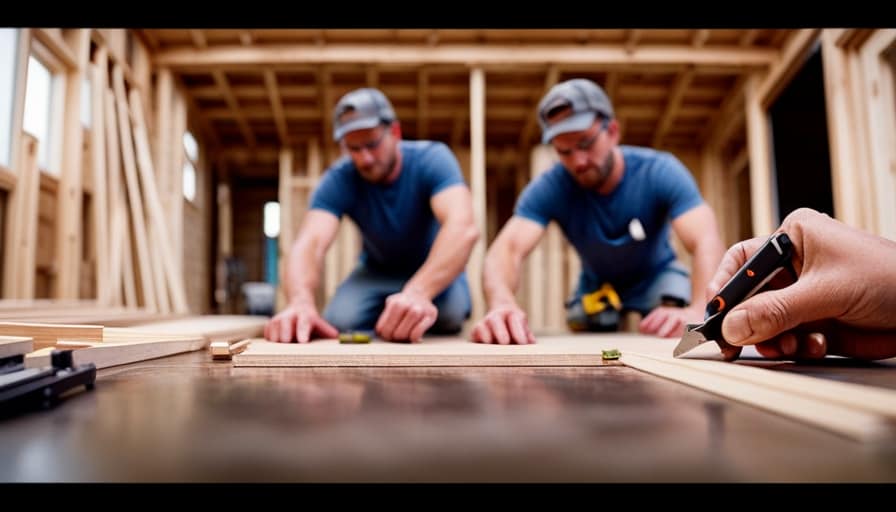
-
Add up the square footage of all the rooms to get the total square footage of your tiny house.
-
Consider the insulation in your walls, roof, and floor. Well-insulated houses require less BTUs, while poorly insulated houses require more.
-
Take into account the number and size of windows in your tiny house. Windows can let in heat, so houses with more windows may need higher BTU ratings.
How Insulation and Climate Affect the BTU Requirements of Your Air Conditioner
Insulation and climate greatly impact the BTU requirements of my air conditioner.
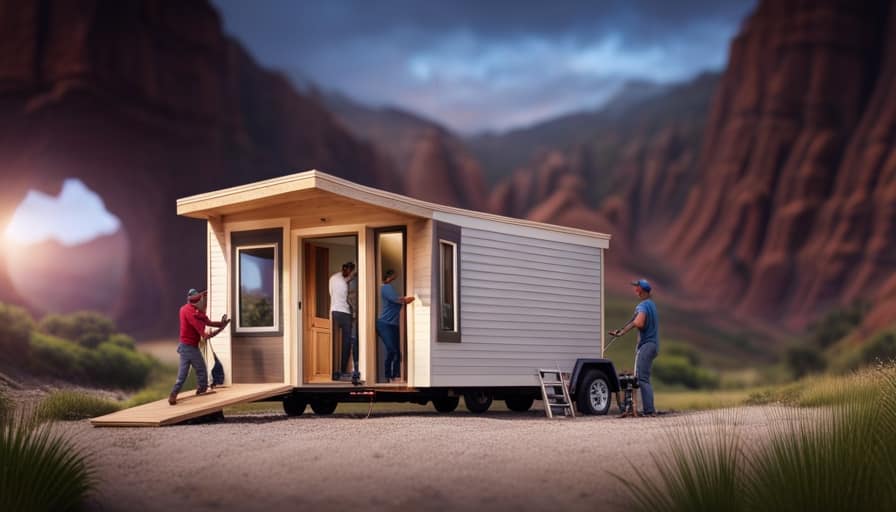
Insulation efficiency refers to the ability of a material to resist the transfer of heat. Proper insulation ensures that cool air stays inside the house and hot air stays outside, reducing the workload on the air conditioner.
Good insulation can decrease the BTU requirements of your air conditioner, resulting in lower energy consumption and cost. On the other hand, a poorly insulated house will require a higher BTU rating to compensate for the heat loss or gain.
Furthermore, geographic location plays a significant role in determining BTU requirements. Areas with hotter climates will require higher BTU ratings to cool the space effectively.
Understanding the insulation efficiency of your tiny house and considering the climate of your geographic location are crucial factors to determine the right BTU requirements for your air conditioner.

Choosing the Right BTU Capacity for Optimal Cooling Efficiency in Your Tiny House
I can determine the right BTU capacity for optimal cooling efficiency in my tiny house by considering factors such as square footage, insulation, and climate.
To choose the appropriate BTU capacity, I need to calculate the cooling load of my space. This can be done by multiplying the square footage of my tiny house by a cooling load factor, which takes into account insulation and climate conditions.
Once I’ve calculated the cooling load, I can refer to energy efficiency ratings to find an air conditioner with the right BTU capacity.
Here are four important factors to consider:
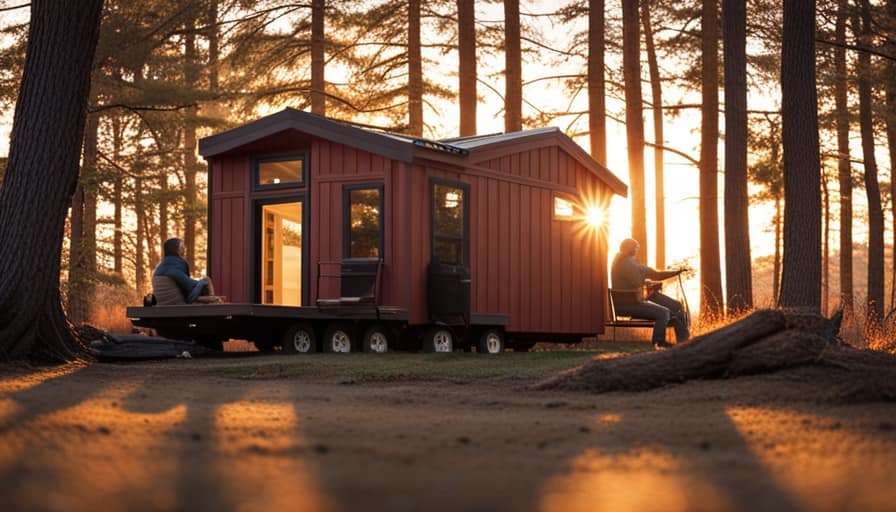
- Square footage of the tiny house.
- Insulation quality and R-value.
- Climate conditions, such as average temperatures and humidity levels.
- The desired temperature and cooling preferences.
Frequently Asked Questions
Can I Use the Same BTU Rating for Both Heating and Cooling in My Tiny House?
Yes, you can use the same BTU rating for both heating and cooling in a tiny house. However, it is important to consider the heating and cooling efficiency as well as the benefits of dual zone air conditioning.
What Is the Average Lifespan of an Air Conditioner in a Tiny House?
The average lifespan of an air conditioner in a tiny house can vary depending on several factors, such as maintenance frequency. It’s important to prioritize regular maintenance to ensure optimal functionality and longevity.
Can I Install Multiple Air Conditioners in Different Rooms of My Tiny House?
I can install multiple portable ACs in different rooms of my tiny house. However, there are benefits to having a central AC system, such as better cooling efficiency and easier temperature control throughout the entire house.
How Often Should I Clean or Maintain My Air Conditioner in a Tiny House?
I should clean or maintain my air conditioner in a tiny house regularly. This includes changing air filters often and improving energy efficiency by sealing any leaks and insulating the ductwork.

Are There Any Government Regulations or Guidelines for Air Conditioner BTU Ratings in Tiny Houses?
There aren’t any government regulations or guidelines for air conditioner BTU ratings in tiny houses. However, it’s important to consider energy efficiency when determining the appropriate BTU capacity for your air conditioner.
Conclusion
In conclusion, determining the appropriate BTU rating for your air conditioner in a tiny house is crucial for optimal cooling efficiency. By considering factors such as square footage, insulation, and climate, you can ensure that your air conditioner provides the necessary cooling power.
Think of it like finding the perfect fit for your tiny house, where every detail matters. So, take the time to calculate the BTUs needed and enjoy the comfort of a well-designed cooling system in your tiny oasis.
I’m Theodore, and I love tiny houses. In fact, I’m the author of Tiny House 43, a book about tiny houses that are also tree houses. I think they’re magical places where imaginations can run wild and adventures are just waiting to happen.
While tree houses are often associated with childhood, they can be the perfect adult retreat. They offer a cozy space to relax and unwind, surrounded by nature. And since they’re typically built on stilts or raised platforms, they offer stunning views that traditional homes simply can’t match.
If you’re looking for a unique and romantic getaway, a tree house tiny house might just be the perfect option.
Beginners Guides
How Do I Make a Tiny House Ladder

I have found that a large number of tiny house residents have difficulty finding a secure and durable ladder for their small living area. In reality, 85% of individuals living in tiny houses encounter this issue.
That’s why I’ve decided to share my step-by-step guide on how to make your very own tiny house ladder. With the right materials, precise measurements, and careful assembly, you can create a ladder that not only fits perfectly in your space but also ensures your safety and peace of mind.
Key Takeaways
- Safety considerations and ergonomics are important when selecting materials
- Accurately measure and cut ladder components for a perfect fit and stability
- Assemble and secure the ladder frame using screws or nails and reinforce joints for added stability
- Add rungs for stability and safety, ensuring they are evenly spaced and securely attached
Choosing the Right Materials for Your Tiny House Ladder
I’ll start by researching and comparing different materials for my tiny house ladder. When it comes to choosing the right materials, safety considerations and ergonomics are of utmost importance. Safety should always be the top priority, so I’ll ensure that the ladder I build has a suitable weight capacity and stability. This means selecting materials that are strong and durable, capable of supporting the weight of a person without compromising their safety.
Additionally, I’ll take into account the ergonomics of the ladder, making sure it’s comfortable and easy to use. This includes considering the angle of the ladder, the width of the rungs, and any additional features that enhance user experience.
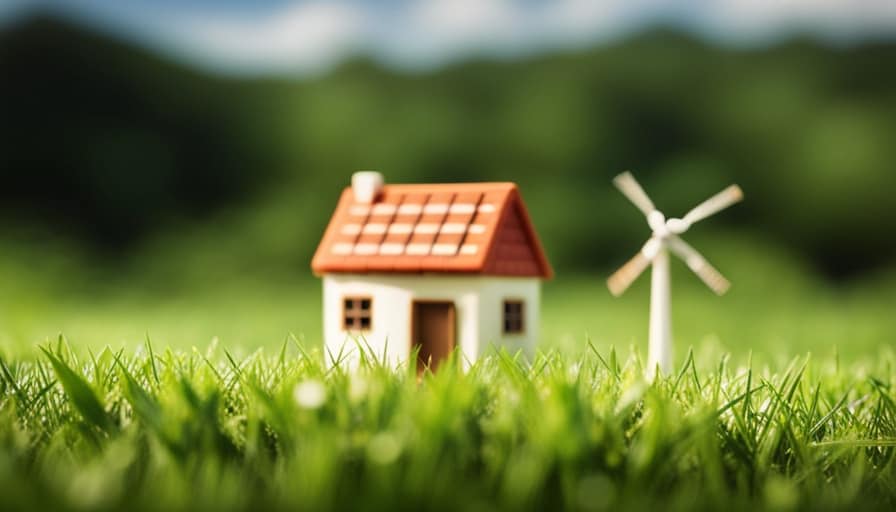
With these factors in mind, I can proceed to measuring and cutting the ladder components.
Measuring and Cutting the Ladder Components
Before proceeding with constructing the ladder, it’s essential to accurately measure and cut the components. Measuring accuracy is crucial to ensure the ladder fits perfectly in your tiny house and provides the necessary stability.
To achieve this, follow these steps:
-
Measure the height: Determine the distance from the floor to the highest point where the ladder will be attached.
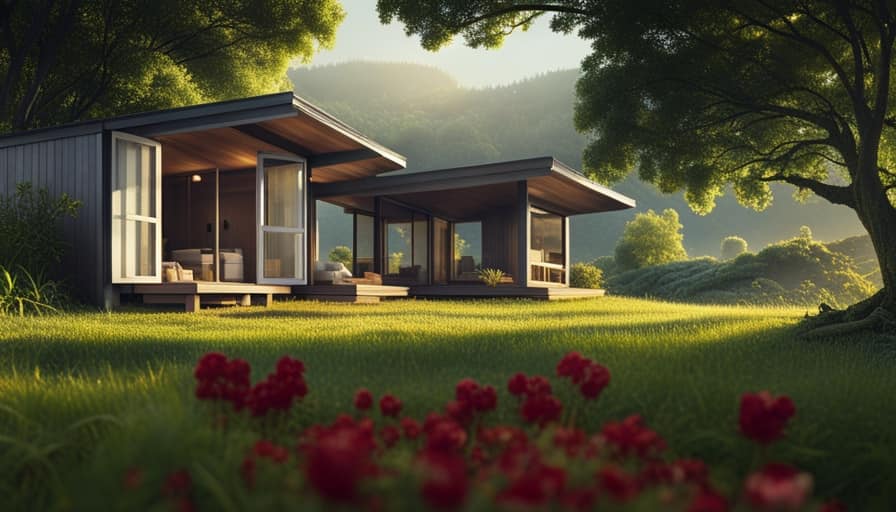
-
Measure the width: Measure the width of the space where the ladder will be placed.
-
Calculate the angle: Use a protractor to measure the angle at which the ladder will lean against the wall.
Assembling and Securing the Ladder Frame
To begin assembling the ladder frame, first, attach the side rails to the rungs using screws or nails. Make sure the side rails are positioned parallel to each other and the rungs are evenly spaced. Use a measuring tape to ensure accuracy.
Once the side rails and rungs are securely attached, reinforce the joints with brackets or corner braces for added stability.
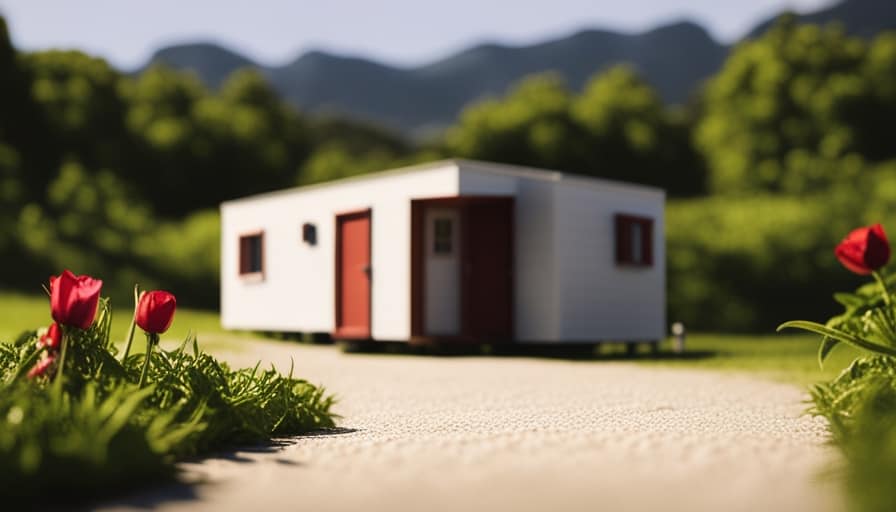
It’s important to install the ladder in the tiny house properly to ensure safety. Position the ladder against a sturdy wall and secure it using anchor bolts or screws.
Regular maintenance is crucial for long-lasting use of the ladder. Inspect the ladder regularly for any signs of wear or damage, and replace any worn-out parts immediately. Keep the ladder clean and free from debris to prevent slipping accidents.
Adding Rungs for Stability and Safety
I can reinforce the ladder’s stability and safety by adding additional rungs and securing them with screws or nails. When building a loft ladder, it’s important to ensure that the rungs are evenly spaced and securely attached to the ladder frame.
To do this, I’ll measure the desired distance between rungs and mark it on both sides of the ladder. Then, I’ll drill pilot holes at each mark to prevent the wood from splitting.
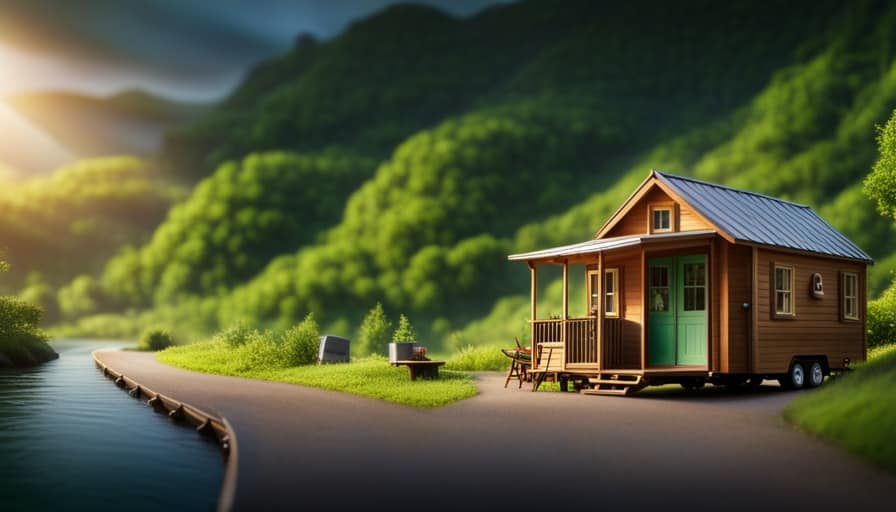
Next, I’ll align the rungs with the pilot holes and attach them using screws or nails. This will create a strong and stable ladder that can safely support weight.
Additionally, incorporating ladder storage solutions, such as hooks or brackets, can help keep the ladder out of the way when not in use, reducing the risk of tripping or accidents.
Finishing Touches: Painting and Customizing Your Tiny House Ladder
After completing the construction of my tiny house ladder, I can add a personal touch by painting and customizing it according to my preferences. Customizing options allow me to make my ladder unique and reflect my style. Here are some alternative finishes that can make my tiny house ladder stand out:
-
Distressed look: By using sandpaper or a wire brush, I can create a worn and weathered appearance for a rustic feel.

-
Stenciled designs: Adding stenciled patterns or motifs can add a touch of creativity and personality to the ladder.
-
Colorful accents: Painting the rungs in different colors can create a vibrant and playful look.
-
Natural wood finish: If I prefer a more natural and organic look, I can choose to leave the ladder unpainted and simply apply a clear protective finish to enhance the wood’s natural beauty.
Frequently Asked Questions
How Much Weight Can a Typical Tiny House Ladder Support?
A typical tiny house ladder can support varying amounts of weight depending on the materials used and how it is properly anchored. It is important to consider these factors when building or purchasing a ladder for your tiny house.
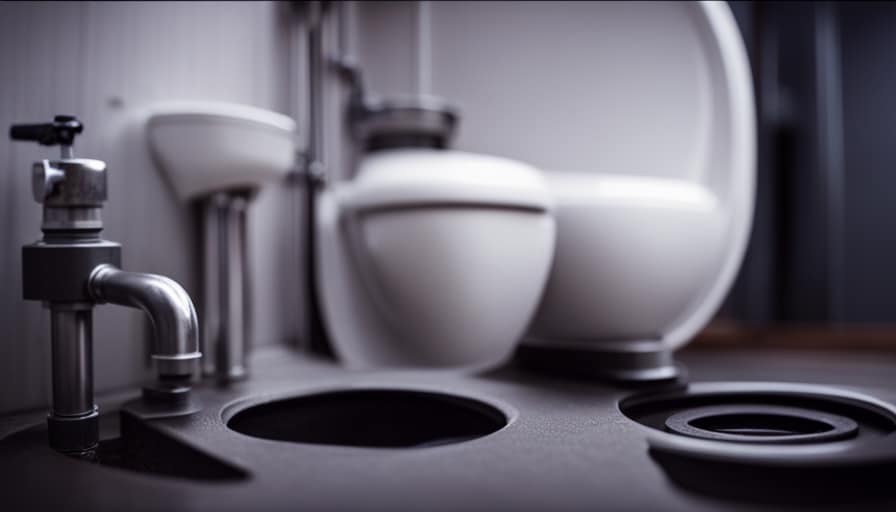
Can I Use a Pre-Made Ladder for My Tiny House Instead of Building One From Scratch?
Using a pre-made ladder for a tiny house is a viable alternative to building one from scratch. However, consider the pros and cons. Building allows customization, while buying offers convenience. Evaluate your needs and skills before deciding.
Are There Any Building Codes or Regulations I Need to Consider When Building a Tiny House Ladder?
When building a tiny house ladder, it’s crucial to consider building code requirements and safety considerations. Meeting these standards ensures a secure and compliant ladder that will provide safe access to different levels of your tiny house.
Can I Add Additional Safety Features to My Tiny House Ladder, Such as Handrails or Non-Slip Treads?
Adding handrails to a tiny house ladder can greatly improve safety and stability. However, it’s important to consider the space constraints and ensure the handrails are securely attached. Non-slip treads can also enhance traction and prevent accidents.
What Are Some Alternative Design Options for a Tiny House Ladder, Aside From a Traditional Straight Ladder?
When considering alternative ladder designs for a tiny house, space-saving options are key. Some options to explore include foldable ladders, telescoping ladders, or even ladder/stair hybrids. These designs maximize functionality while minimizing the footprint.

Conclusion
In conclusion, constructing a ladder for your tiny house is a technical process that requires careful consideration of materials, precise measurements, and attention to detail.
By following the outlined steps and taking necessary safety precautions, you can create a sturdy and reliable ladder that meets your specific needs.
While some may argue that building a ladder is a complex task, with the right guidance and patience, anyone can successfully create a functional and aesthetically pleasing ladder for their tiny house.
I’m Theodore, and I love tiny houses. In fact, I’m the author of Tiny House 43, a book about tiny houses that are also tree houses. I think they’re magical places where imaginations can run wild and adventures are just waiting to happen.
While tree houses are often associated with childhood, they can be the perfect adult retreat. They offer a cozy space to relax and unwind, surrounded by nature. And since they’re typically built on stilts or raised platforms, they offer stunning views that traditional homes simply can’t match.
If you’re looking for a unique and romantic getaway, a tree house tiny house might just be the perfect option.
Beginners Guides
How Do I Hook up a Tiny House

I have always fantasized about living in a small house, but connecting it to utilities seemed overwhelming. That’s why I chose to explore the realm of small house hookups and share my discoveries with you.
In this article, we’ll explore everything from choosing the right location to connecting to water, electricity, and sewage systems. So, if you’re ready to turn your tiny house dreams into reality, let’s get started on this step-by-step journey together.
Key Takeaways
- Choose a clean and safe water source and use a water pressure regulator and filtration system.
- Consider grid connection for reliable electricity and install solar panels and batteries for free electricity.
- Install a septic tank or connect to a municipal sewer system and use composting toilets and greywater systems for an eco-friendly approach to waste management.
- Ensure proper ventilation for good air quality, implement fire safety measures, and comply with safety regulations and building codes.
Choosing the Right Location for Your Tiny House
I’ve always dreamed of finding the perfect spot to set up my tiny house. When choosing the right location, there are two important factors to consider: zoning regulations and environmental impact.
First, it’s crucial to understand the zoning regulations in the area where you plan to place your tiny house. Different jurisdictions may have specific requirements and restrictions regarding the size, placement, and usage of tiny houses. Researching and complying with these legal requirements will ensure a smooth and hassle-free experience.

Additionally, it’s essential to consider the environmental impact of your chosen location. Look for a spot that minimizes disruption to the natural surroundings and promotes sustainability. Consider factors such as access to public transportation, proximity to amenities, and the potential for renewable energy sources.
Water Hookup: Connecting Your Tiny House to a Water Source
To connect my tiny house to a water source, I’ll need to use a hose and a water pressure regulator.
First, I’ll locate the water source and ensure it’s clean and safe.
Next, I’ll attach the water pressure regulator to the hose to control the water flow. This is important to prevent any damage to the plumbing system in my tiny house.

Before connecting the hose to the water source, it’s recommended to use a water filtration or purification system to ensure clean and safe water for everyday use.
Once the hose is connected, I’ll turn on the water source and check for any leaks.
It’s important to regularly maintain and clean the water filtration or purification system to ensure optimal performance and safe drinking water in my tiny house.
Powering Your Tiny House: Electricity Hookup Options
There are several electricity hookup options available for powering my tiny house. The most common ones are grid connection, solar power, and generator.

Grid connection involves connecting my tiny house to the local power grid. This option provides a reliable source of electricity. It requires installing a meter and paying monthly utility bills.
On the other hand, solar power is a more sustainable and environmentally friendly option. By installing solar panels on the roof of my tiny house, I can harness the power of the sun to generate electricity. Though it requires an initial investment in the solar panels and batteries, it can provide me with free electricity in the long run.
Lastly, generator options are available for those who prefer a backup power source. A generator can be used to power my tiny house when there’s no access to grid electricity or when the solar panels aren’t generating enough power. It’s important to choose a generator that’s suitable for the power needs of my tiny house and to have a reliable fuel source.
Transitioning into the next section on waste management, it’s important to consider how to hook up my tiny house to sewage systems.
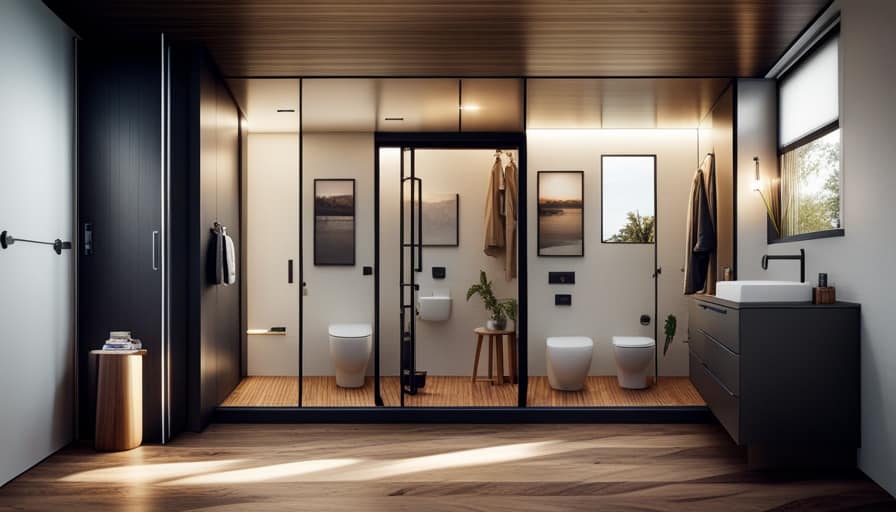
Waste Management: Hooking up Your Tiny House to Sewage Systems
I can connect my tiny house to sewage systems using either a septic tank or a sewer hookup. When it comes to waste management in a tiny house, there are a few options to consider. Here are three ways to hook up your tiny house to sewage systems:
-
Septic tank: Installing a septic tank requires digging a hole in the ground and placing a large tank where waste can be collected and treated. This is a more permanent solution that requires regular maintenance and pumping.
-
Sewer hookup: If your tiny house is located in an area with access to a municipal sewer system, you can connect directly to it. This option eliminates the need for a septic tank and allows for easy disposal of waste.
-
Composting toilets and greywater systems: If you prefer a more eco-friendly approach, you can install a composting toilet and a greywater system. Composting toilets use natural processes to break down waste, turning it into compost. Greywater systems collect and filter wastewater from sinks and showers, allowing it to be reused for irrigation.
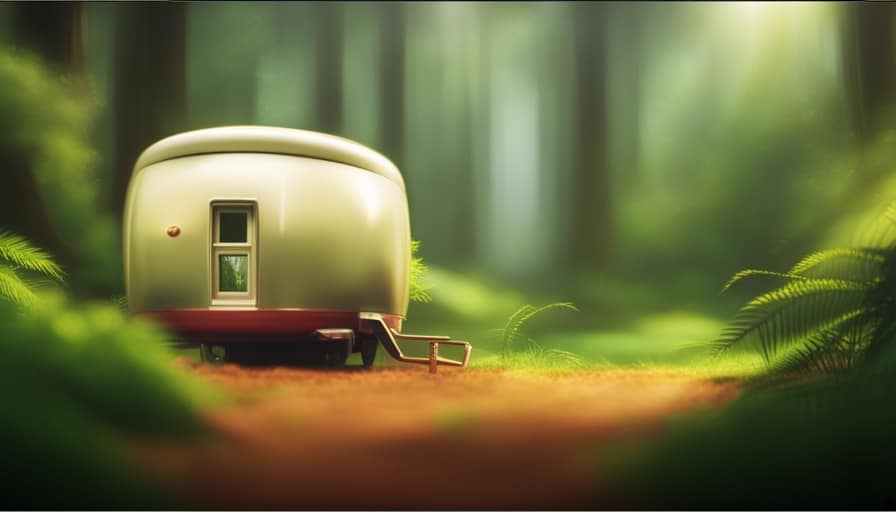
By utilizing these waste management options, you can ensure a clean and efficient sewage system for your tiny house.
Transitioning into the next section, it’s important to also consider safety and compliance in all aspects of your tiny house hookups.
Ensuring Safety and Compliance in Tiny House Hookups
One must ensure that their tiny house hookups are safe and compliant with regulations. Ensuring proper ventilation and fire safety measures are crucial steps in making sure that your tiny house is a safe and comfortable place to live. Here are some steps to follow:
-
Ventilation: Proper ventilation is important to maintain good air quality and prevent the buildup of moisture and odors. Install exhaust fans or vents in the kitchen, bathroom, and any other areas where moisture or fumes may accumulate.

-
Fire Safety Measures: Fire safety is paramount in any living space. Install smoke detectors and carbon monoxide detectors in your tiny house. Place fire extinguishers in accessible locations and ensure that they are regularly inspected and maintained.
-
Compliance with Regulations: Familiarize yourself with local building codes and regulations to ensure that your tiny house meets all safety requirements. This includes electrical, plumbing, and structural components.
By taking these precautions, you can enjoy your tiny house while also ensuring the safety and compliance of your hookups.
| Safety Measures | Steps to Follow |
|---|---|
| Ventilation | Install exhaust fans or vents in kitchen, bathroom, and other areas where moisture or fumes accumulate. |
| Fire Safety Measures | Install smoke detectors, carbon monoxide detectors, and fire extinguishers. Familiarize yourself with local building codes and regulations. |
| Compliance with Regulations | Ensure that your tiny house meets all safety requirements, including electrical, plumbing, and structural components. |
Frequently Asked Questions
How Much Does It Cost to Hook up a Tiny House to a Water Source?
When hooking up a tiny house to a water source, the cost can vary depending on factors like location and type of connection. It’s important to compare costs and consider alternative options to find the best solution for your budget.
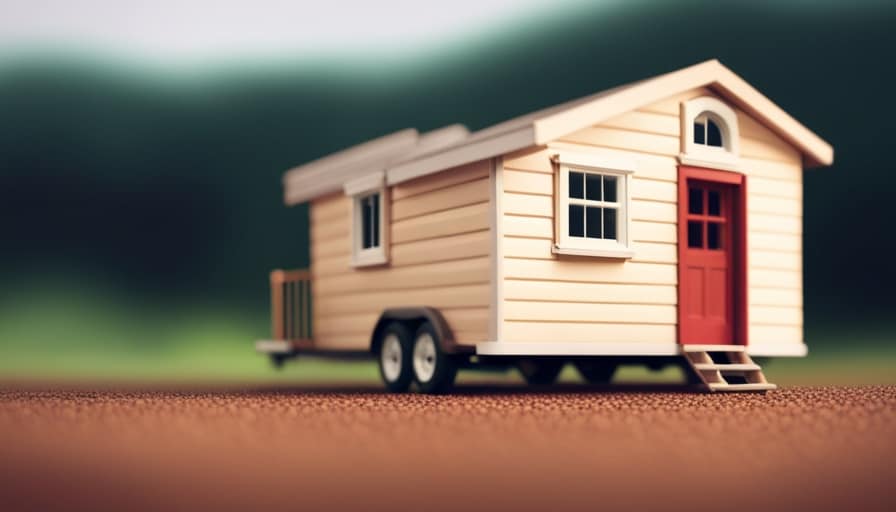
Can I Hook up My Tiny House to a Well Instead of a Municipal Water Source?
Well water versus municipal water for a tiny house has its pros and cons. While a well can provide independence and cost savings, it requires maintenance and may have limited supply. Municipal water offers convenience but comes with monthly bills.
Are There Any Specific Electrical Codes or Regulations I Need to Be Aware of When Hooking up My Tiny House?
When hooking up a tiny house, it’s crucial to be aware of electrical code requirements and safety precautions. These regulations ensure that your electrical system is safe and up to standard. Always consult with a licensed electrician to ensure compliance.
How Often Do I Need to Empty My Tiny House’s Sewage System?
To maintain my tiny house sewage system, I make sure to clean it regularly. The frequency depends on usage, but generally, it needs to be emptied every 1-3 weeks. Proper maintenance ensures a clean and odor-free living environment.
Can I Install Solar Panels to Power My Tiny House Instead of Connecting to the Grid?
I can install solar panels to power my tiny house instead of connecting to the grid. It offers benefits like energy independence, lower utility bills, and environmental friendliness. However, it may require a larger upfront investment and limited power supply on cloudy days.

Conclusion
In conclusion, hooking up a tiny house requires careful consideration of several factors. These include the location of the house, the available options for water hookup, the available options for electricity hookup, and waste management. By following the step-by-step instructions provided in this article, you can ensure a safe and compliant setup for your tiny house.
So, are you ready to embark on your tiny house adventure and create a cozy and sustainable living space?
I’m Theodore, and I love tiny houses. In fact, I’m the author of Tiny House 43, a book about tiny houses that are also tree houses. I think they’re magical places where imaginations can run wild and adventures are just waiting to happen.
While tree houses are often associated with childhood, they can be the perfect adult retreat. They offer a cozy space to relax and unwind, surrounded by nature. And since they’re typically built on stilts or raised platforms, they offer stunning views that traditional homes simply can’t match.
If you’re looking for a unique and romantic getaway, a tree house tiny house might just be the perfect option.
-

 Beginners Guides2 weeks ago
Beginners Guides2 weeks agoHow To Buy A Tesla Tiny House
-

 Energy Efficiency1 month ago
Energy Efficiency1 month agoBest Tiny Homes For Cold Climates
-

 Beginners Guides7 days ago
Beginners Guides7 days agoTiny House Nation Where Are They Now Stephanie
-

 Tiny House Resources (e.g., legalities, cost, insurance, FAQs)2 months ago
Tiny House Resources (e.g., legalities, cost, insurance, FAQs)2 months agoDo Tiny Homes Need Planning Permission?
-

 Beginners Guides2 weeks ago
Beginners Guides2 weeks agoFrom The Show Tiny House Nation How Many Keep Their Tiny House?
-

 Beginners Guides2 months ago
Beginners Guides2 months agoUsing a Climbing Net For Treehouse Construction
-

 Beginners Guides2 months ago
Beginners Guides2 months agoHow to Build a Treehouse Without Drilling Into the Tree
-

 Beginners Guides3 weeks ago
Beginners Guides3 weeks agoTiny House Nation Who Pays For The Houses





